MARIANI’S
June 12, 2005
NEWSLETTER
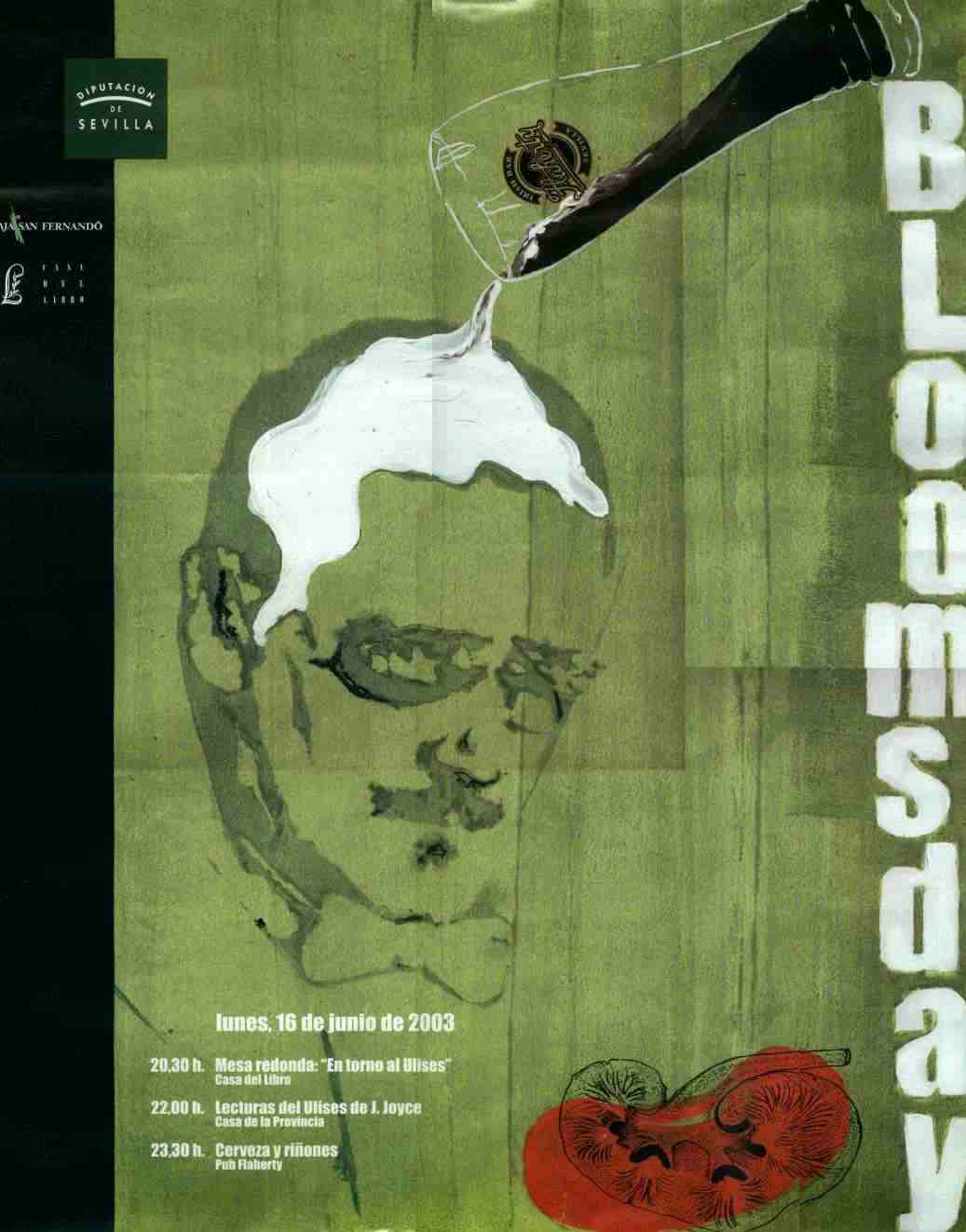
--James Joyce, Ulysses (1922).
UPDATE: To
go to my web site, in which I will update food
&
travel information and help link readers to other first-rate travel
& food sites, click on: home page
ACCESS TO
ARCHIVE: Readers may now access
an
Archive of all past newsletters--each annotated--dating back to July,
2003, by simply clicking on www.johnmariani.com/archive
.
NEW
FEATURE! You may now subscribe anyone you wish
to this newsletter by
clicking here.
Away in
Alsace: Strasbourg by John Mariani
NOTES
FROM THE WINE CELLAR: Alsatian Wines Gain Cachet by John Mariani
NEW
YORK CORNER: Mario's by John Mariani
QUICK
BYTES
Away
in Alsace: Strasbourg by John Mariani
Photos by Galina
Stepanoff-Dargery
Travel poster by Roger Broders, 1926
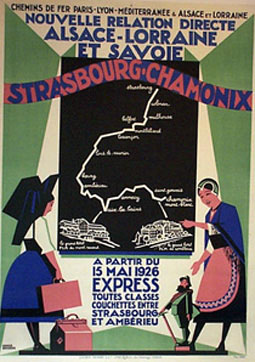
The history of the dish is rich, its local popularity evident from the number of restaurants in Strasbourg that serve it and the crowds of locals that pack them, and the enjoyment of the dish is amply increased with either a glass of Alsatian beer or a bottle of Alsatian wine (see next story). Astonishingly, the latest (2001) English-language edition of Larousse Gastronomique does not even have a separate listing for the dish, nor is there any recipe listed in the index. You have to look under "sauerkraut" (choucroute in French) to find one, provided by the beloved Alsatian artist called "Hansi."
We checked into the very pleasant, centrally located Beaucour-Baumann Romantik (5 Rue des Bouchers; 03-88-76-7200; www.hotel-beaucour.com), located just steps from the Quai Saint-Nicolas in an 18th-century timbered building that was once a cane and umbrella factory. Just up the block, we sated our aching hunger for choucroute à l'alsacienne at Au Pont de Corbeau (21 Quai Saint-Nicolas; 03-88-35-6068).
At lunch there is a remarkably priced €11 ($13.40) menu that includes a generous salade frisée aux lardons, with its typical mix of greenery, saltiness, texture and tang, and an outstanding, creamy onion tart. There was also a delicious sauerkraut tart, and then the dish we'd be waiting for--a huge portion of choucroute à l'alsacienne that met expectations and immediately restored our spirits. Two local fellows at the next table regretted we hadn't tried the restaurant's Alsatian hamburger, a kind of Salisbury steak that they were mopping up with mashed potatoes and brown gravy. But by then but we were on to a good cherry custard tart and a glass of Vendange Tardive gewürztraminer.
That afternoon we toured the city, whose interior, historic center takes but a couple of joyous hours to walk around, by which time you will have a clear sensibility about the prim, impeccably proper way of the people here.
After the severe deprivations of the Thirty Years War (1618-48), the city came under French rule, then a century later went back to German hands in the Franco-Prussian War, then returned to France after World War I by the Treaty of Versailles. In the next war the Germans exacted heavy damage to the city, but its historic integrity has survived, nowhere better appreciated than in its magnificent Cathedral
Make no mistake, however, whether the Alsatians think of themselves as French or German, for while many family, town, and street names, including Strasbourg itself, are Germanic and everyone has German relatives, the Alsatians are resolutely French, even if they have a streak of Teutonic reserve about them.
(One of the best ways to take advantage of it all is to obtain a "Strasbourg Pass," which for €10.60 [$13] gives you three days free admission or 50% reductions to museums, a riverboat, and more.)
Later that evening, my wife and I dined at the city's premier seafood restaurant, L'Alsace à Table (8 Rue Francs-Bourgois; 03-88-32-5062; www.alsace-a-table.fr). Guy-Pierre Baumann is the guiding light of the restaurant
Baumann claims to have invented "seafood choucroute," which doesn't seem much of a stretch, but I was much happier with grilled and roasted fish done simply or with rich cream sauces. It is difficult not to order platter after platter of grilled langoustines once you see them displayed here. They are sweet and delicious and meaty. There are also several options for platters of fruits de mer--oysters, shrimps, and clams in various portion sizes.
The wine list has a good selection of Alsatian labels. The fact that the restaurant is open seven days a week is also appealing for anyone hungry on a Sunday afternoon or evening in Strasbourg.
The next day's lunch was at Au Vieux Strasbourg (5 Rue du Maroquin; 03-88-32-4189), located "à l'ombre de la cathédrale," done up prettily on two floors in the traditional decor of this beautiful medieval city, with timbers,
The food here was hearty and good--excellent quiche lorraine and a jarré de porc with sauerkraut--though the onion soup gratinée was thin and the onions not well caramelized. There was no attempt at finesse in the cooking, but we certainly did not leave hungry, and the bottle of Zotzeberg Riesling 2001 went down easily. Our bill came to about $60 for the two of us.
It would have been easy to linger over coffee and brandy here, but jet lag took its toll and we repaired to bed for a short winter's nap.
Strasbourg has its share of Michelin stars, most notably Buerehiesel (three) and Au Crocodile (two), which I've visited in the past and feel they deserve their recognition. This time we went instead to La Vieille Enseigne (9 Rue Tonneliers; 03-88-32-5850),
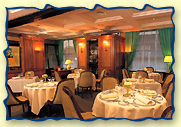 which lost its single star just weeks before our
arrival, but it is still a very
fine and beautiful restaurant (right)
with a good balance of the classic and
the modern on its menu. The comfort of the restaurant is ideal;
you get a warm welcome without
effusiveness, and the place has
sophistication without pretense even
down to the chairs that move smoothly and quietly over the carpet
and the sconces that cast a soft glow on everyone. Tables are
nicely separated from each other; wood mouldings are topped with
calligraphy of bistro food items; exotic flowers are set in Lalique
bowls on a pedestal; and the guests seem as polite as the staff: two
gentlemen at a table adjacent to ours asked us if they might
smoke.
which lost its single star just weeks before our
arrival, but it is still a very
fine and beautiful restaurant (right)
with a good balance of the classic and
the modern on its menu. The comfort of the restaurant is ideal;
you get a warm welcome without
effusiveness, and the place has
sophistication without pretense even
down to the chairs that move smoothly and quietly over the carpet
and the sconces that cast a soft glow on everyone. Tables are
nicely separated from each other; wood mouldings are topped with
calligraphy of bistro food items; exotic flowers are set in Lalique
bowls on a pedestal; and the guests seem as polite as the staff: two
gentlemen at a table adjacent to ours asked us if they might
smoke.Photo courtesy of La Vieille Enseigne
Chef J. Christophe Langs cooks in a thoroughly French style with modern flourishes, So, we began with a shooter of liquefied salmon sipped through a straw and little samosa-like pastries stuffed with crab meat. An appetizer of foie gras with apricots was of the high quality you expect from the region that perfected foie gras, and langoustines were done in a light tempura batter accompanied by a lovely eggplant terrine. Poached pike with a sauerkraut pancake was a tad bland, but squab cooked pink was delicious as a main course. This was followed by an odd shooter of pudding as a pre-dessert, unidentifiable as a flavor, and the meal ended with some decadent chocolate beignets.
The wine list is among the best in Strasbourg, leaning heavily on the local offerings but with a good selection of other regional French wines. Prices for a meal here are very reasonable: a 5-course seafood menu is €59 ($72 ); otherwise, main courses à la carte run €27 ($33) to €31 ($38).
The next day we were off on the Wine Trail and on to Colmar and Selestat, which are stories for another time in the not-too-distant- future.
NOTES
FROM THE WINE CELLAR
Alsatian
Wines Gain Real Cachet
by John Mariani
The
wines of
Believing that when in Alsace, drink as
the Alsatians do, I did nothing but on my trip, especially the Grand
Crus which
the Institut National des Appellations
d'Origine began selecting in 1983. (For a complete listing of the
Grand Cru
Vineyards, visit www.alsacewine.com)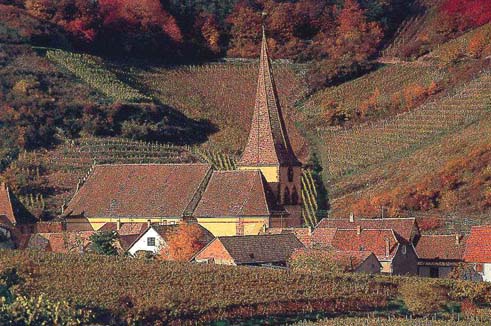
Although some of the better-known
estates, including Trimbach and Leon Beyer, do not choose to use the
Grand Cru
name on the labels of their best wines, the appellation carries
enormous
prestige. Grand Crus only account for 10 percent of
``I think we Alsatian vignerons are
quickly overcoming the image of being merely `regional' wines,'' says
Georges
Lorentz, 39, managing director of the Gustave Lorentz winery in
Bergheim in the
foothills of the
The best way
to appreciate the wine
country is to drive through the winding, carefully marked,
170-kilometer Route
des Vins d'Alsace (www.alsace-route-des-vins.com),
which rambles from
Thann in the west to Marlenheim in the east. While touring the area, do
visit the
NEW
YORK
CORNER
by John Mariani
Mario's
2342
Arthur Avenue, Bronx
718-584-1188
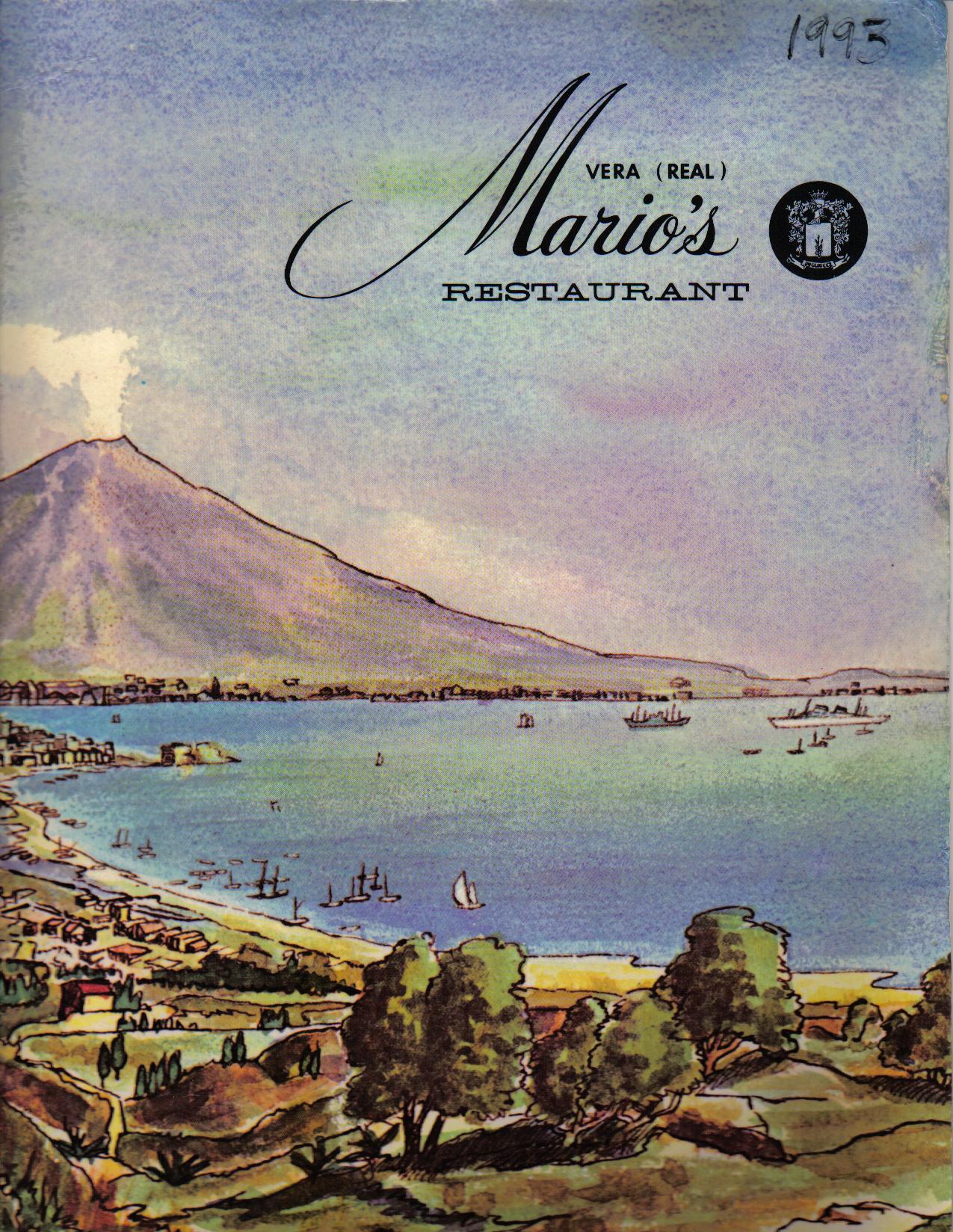
Indeed, a few years ago Mario's was recipient of the James Beard Award as one of "America's Classics," which it most certainly is.
Located since 1919 in the Belmont section of Fordham (where Dion and the Belmonts began singing doo-wop on a street corner of Arthur Avenue and 187th Street), Mario's has been run by five generations of the Miglucci family, including Rose, now the materfamilias of the clan, who is still there most days and nights making sure all is done as her late husband did it, as his father did it, and as her son Joseph and his son, Mario, and daughter, Regina, continue to do it. It's an unbreakable chain of commitment, day in, day out, six days and nights a week. When the Migluccis go on vacation, Mario's closes.
The
pizzas here are legendary—perfect Neapolitan pies of
impeccable crust, not thick but not too thin, beautifully seared on the
bottom,
bubbly and charred, with a topping of nothing more than fresh tomato,
fresh mozzarella, olive oil,
and basil—the epitome of a great pizza. Mario’s serves pizzas during the day, but in
the evening only as an
adjunct to a meal. And, given the size
of Mario’s portions, the thought of a pizza as an appetizer can be a
little
daunting. Somehow my family and I always
manage, because we are helpless to resist.
The pasta sauces are all made to order here, and several
of the pastas are themselves made on the premises; the rest are
purchased from first-rate shops in the neighborhood. I love their
ricotta cavatelli with fresh tomato sauce; the perfectly al dente spaghetti teeming with
huge amounts of chopped clams (or in the shell, if you
prefer), rigatoni glistening with broccoli di rabe in oil
and slivers of garlic with chunks of fennel
sausage; luscious and creamy manicotti, and baked ravioli. The stuffed
eggplant is first rate, the fried calamari perfectly golden, crisp and
tender. If they have
langoustines, order them simply grilled,
although seafood is not Mario's strong point; better are their lamb
chops and all their veal dishes, including the
Italian-American cliché of clichés, veal alla parmigiana,
made the way it
should be, with excellent veal, fresh tomato and melting mozzarella—a
superb
dish in every scrumptious way. Even a
broiled chicken, accompanied by a cheese-rich potato croquette and some
sautéed
spinach, is a feast at Mario’s.
Desserts are afterthoughts here--a trolley
of Italian-American specialties not unlike everyone else's--but the
cheesecake is of good quality, and they know how to make a rich cup of
espresso. The wine list has long needed expanding, but I don't
think this is likely in the near future. Everyone seems pretty happy
with
the same chiantis and pinot grigios they've had here for years.
Mario’s
looks have changed little over the years, although the place is always
happily festooned with family photos, varnished paintings of Mount
Vesuvius, Italian statuary, pink banquettes, and plenty of photos of
famous people who have dined here, meaning every New York sports figure
and pol, rock-and-roll stars, famous restaurateurs like Sirio Maccioni
and Julian Niccolini, and actors who grew up here, like Chazz
Palmentieri, who wrote the play and subsequent movie "A Bronx Tale,"
his personal fantasy about life in the neighborhood.
Arthur Avenue has a lot of old-fashioned
Italian-American eateries, some known for one or two dishes, others,
like Dominick's, known for its communal tables and lines out the door,
and one, Roberto's, known for its superb regional and personalized
Italian cooking. There's also a new branch of Umberto's Clam
House on the Avenue, and a very fine Omaha Steakhouse around the block.
There are good pizzerias (though none as good as Mario's) and
cafés,
and seafood markets where you can slurp raw shellfish with a squeeze of
lemon and hot sauce at an outdoor
counter.
Mario's, whose roots are Neapolitan, is part
of this very American fabric, and, for its longevity and commitment, it
has had a role in holding the neighborhood together through thick and
thin. Things are thick right now, the neighborhood doing very
well, and it's as safe a place as you'll find in the very safe City of
New York. If you want to see
the real Little Italy in action, go up to the Bronx, not down to the
edge of Chinatown in Manhattan. Take in a Yankees game, visit the Bronx
Zoo or the Botanical Gardens, then retire to a banquette at Mario's.
You'll never spend a better day.
Pastas run $10.50-$12, main
courses $14.75-$18.95.
OY VEY, SAMMY DAVIS JR. IS GONNA PLOTZ!
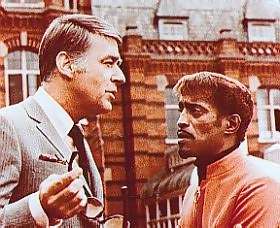
KEEP IT QUIET! EVERYONE WILL WANT ONE!
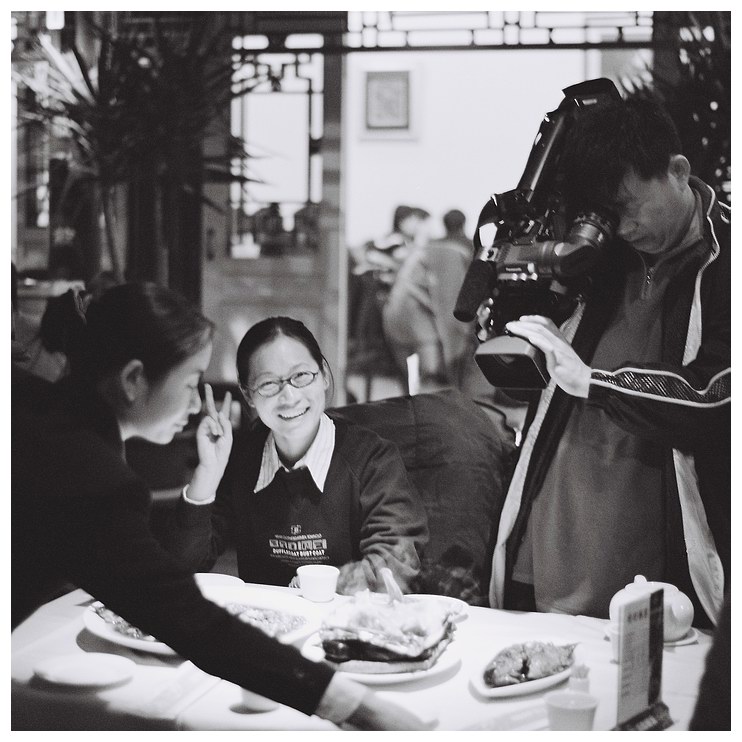
DEPARTMENT OF CORRECTIONS
In an article on New York cheesecake two weeks ago, I erroneously noted that Patsy's restaurant no longer makes its own. It most certainly still does, and, as previously noted, it's a great one.
QUICK BYTES
* On June 22 Gabriel’s Restaurant in
~~~~~~~~~~~~~~~~~~~~~~~~~~~~~~~~~~~~~~~~~~~
MARIANI'S VIRTUAL GOURMET NEWSLETTER is published weekly. Editor/Publisher:
John Mariani. Contributing Writers: Robert Mariani, Naomi
Kooker, Kirsten Skogerson, Edward Brivio, Mort
Hochstein, Lucy Gordan, Suzanne Wright. Contributing
Photographers: Galina Stepanoff-Dargery, Bobby Pirillo. Technical
Advisor: Gerry McLoughlin.
Any of John Mariani's books below
may be ordered from amazon.com by clicking on the cover image.
 |
 |
 |
 |
 |
 |
copyright John Mariani 2005